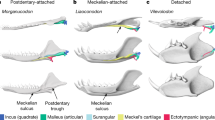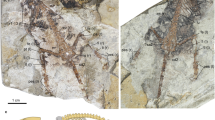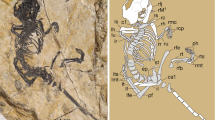Abstract
In spite of many criticisms, the Reichert-Gaupp theory of the mammalian ear ossicles1, 2, 3, 4 has, in its main points, been confirmed by a considerable body of work on the developmental anatomy of recent mammals and reptiles, and on the structure of therapsid reptiles. There can be little question that the stapes, incus and malleus (except for its dermal component, the goniale of Gaupp) are essentially homologous respectively with the reptilian columella auris (proximal part or otostapes), quadrate and articular. The existence of vestiges of other elements of the reptilian lower jaw and extrastapes in the mammalian middle ear has been suggested by numerous investigators. Thus the goniale is usually equated with the pre-articular1, 2, 3, 4, etc., and the elements of Paauw and Spence have been regarded as parts of the extrastapes5. But in general there has been little agreement on the detailed homology of the parts of the stapes, of the crura of the incus, and of the various processes of the malleus; this is largely because most of our information on these points is based on the anatomy of adult and embryonic stages of living mammals and reptiles, while mammals originated from the extinct therapsid reptiles, which differ from Lacertilia and Sphenodon in important respects. Until recently, too little was known in detail about the middle ear and lower jaw of therapsids, though Broom6 showed the position of the tympanic membrane and the presence of an ossified portion of the extrastapes in some Therocephalia (see also ref. 7). E. C. Olson8 has now provided, among other interesting things, an account of the structure of the otic region of several therapsids (Anomodontia, Therocephalia, Gorgonopsia, Cynodontia) based on serial sections. The structure of the middle ear region is greatly illuminated by this work; but some of his conclusions seem to be open to question, while others can be further supported.
This is a preview of subscription content, access via your institution
Access options
Subscribe to this journal
Receive 51 print issues and online access
$199.00 per year
only $3.90 per issue
Buy this article
- Purchase on Springer Link
- Instant access to full article PDF
Prices may be subject to local taxes which are calculated during checkout
Similar content being viewed by others
References
Gaupp, E., Arch. Anat. Physiol., I Teil (Arch. Anat. Entw.-Gesch.) Supp. Bd., 1 (1912).
van der Klaauw, C. J., Z. ges. Anat., I Teil (Z. Anat. Entw.-Gesch.), 69, 32 (1923).
Goodrich, E. S., "Studies on the Structure and Development of Vertebrates" (London, 1930).
de Beer, G. R., "The Development of the Vertebrate Skull" (Oxford, 1937).
van der Klaauw, C. J., Ergebn. Anat. Entw.-Gesch., 25, 565 (1924).
Broom, R., Phil. Trans., B, 226, 1 (1936), esp. pp. 23–4, 27, figs. 102, 103, 121.
Westoll, T. S., Proc. Roy. Soc., B, 131, 393 (1943).
Olson, E. C., Geol. Soc. Amer., Spec. Papers, No. 55 (1944).
Findlay, G. H., Proc. Zool. Soc. Lond., 114, 91 (1944).
van Kampen, P. N., Morph. Jahrb., 34, 321, 372 (1905).
Watson, D. M. S., Phil. Trans., B, 207, 311, 361 (1916).
Broom, R., Proc. Zool. Soc., 449, 454, 457, pl. 2, fig. 9 (1916).
Forster Cooper, C., Phil. Trans., B, 216, 265, 267, text-fig. 1 (1928).
Author information
Authors and Affiliations
Rights and permissions
About this article
Cite this article
WESTOLL, T. New Light on the Mammalian Ear Ossicles. Nature 154, 770–771 (1944). https://doi.org/10.1038/154770b0
Issue Date:
DOI: https://doi.org/10.1038/154770b0
This article is cited by
-
The Mammalian Middle Ear
Nature (1945)
Comments
By submitting a comment you agree to abide by our Terms and Community Guidelines. If you find something abusive or that does not comply with our terms or guidelines please flag it as inappropriate.



